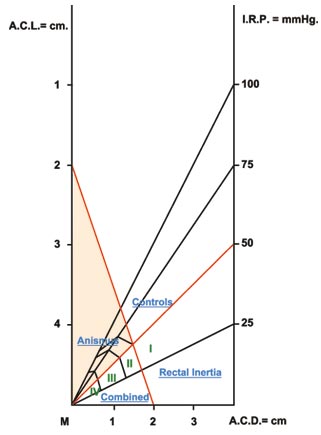| Back
to main page
The
Equation
Flow
Index calculator
Flow
Index contispation
Defecation Norm Gram
Anal Incontinence
Continence Norm Gram
Applications of use of the Theory
Facts and Controversies
|
- Where
Zone I includes :
1. Normal unobstructed defecation.
2.
Patients who have constipation due to hard stools, Colonic Inertia,
or mechanical factor such as Rectocele or Intussusceptions who
is expected to regain normal defecation after correction of
the cause.
Zones II, III and IV: Include
patients with underlying Anismus and/or Rectal Inertia.
Zone II: Obstructed defecation
for soft well formed stools.
Zone III: Obstructed defecation
for watery stools.
Zone IV: Obstructed defecation
for Gas.

- The
minimum normal anal canal resistance was represented by the
line connecting A.C. Length 2 cm. And A.C. Diameter =2 cm.
- And
The minimum normal Intrarectal pressure was represented by line
connecting IRP.=50 mmHg and point M.
- Defining
Anismus, rectal inertia, combined cases and normal controls.
- Some
of Anismus patients lie in zone I of normal defecation being
compensated for by increased Intrarectal pressure during defecation
which had led to the controversies about the role of Anismus
in constipation .
- Those
cases are compensated Anismus patients who should not be recruited
as normal controls, who should be recruited only from the control
area above and in- front of both lines.
Next Page
|

